Question Number 35844 by behi83417@gmail.com last updated on 24/May/18
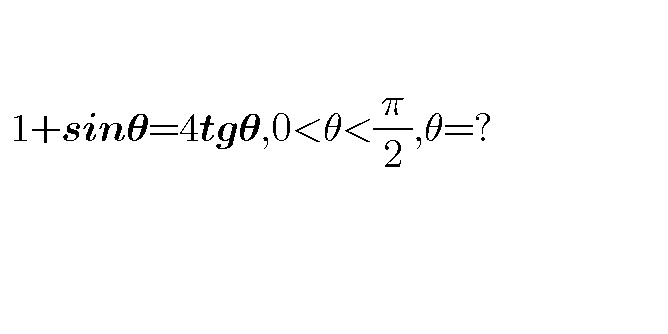
Commented by abdo mathsup 649 cc last updated on 30/May/18
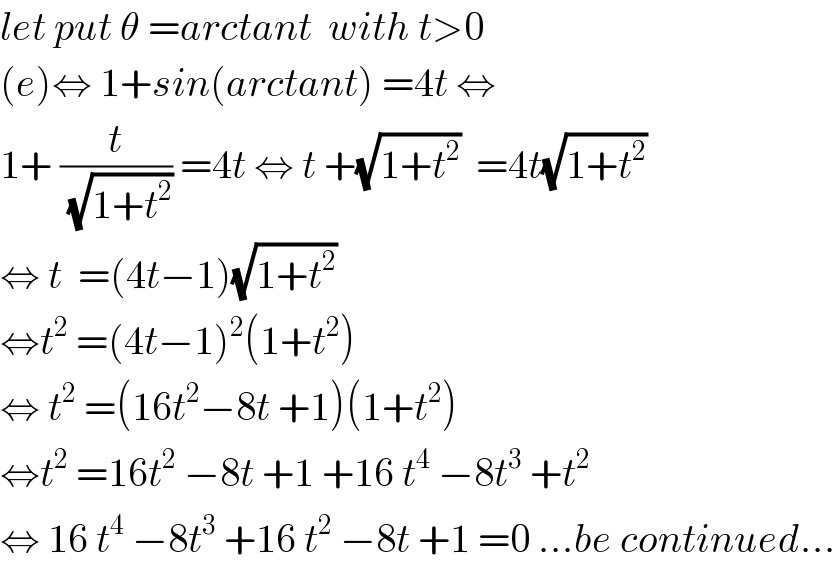
$${let}\:{put}\:\theta\:={arctant}\:\:{with}\:{t}>\mathrm{0} \\ $$$$\left({e}\right)\Leftrightarrow\:\mathrm{1}+{sin}\left({arctant}\right)\:=\mathrm{4}{t}\:\Leftrightarrow \\ $$$$\mathrm{1}+\:\frac{{t}}{\:\sqrt{\mathrm{1}+{t}^{\mathrm{2}} }}\:=\mathrm{4}{t}\:\Leftrightarrow\:{t}\:+\sqrt{\mathrm{1}+{t}^{\mathrm{2}} }\:\:=\mathrm{4}{t}\sqrt{\mathrm{1}+{t}^{\mathrm{2}} } \\ $$$$\Leftrightarrow\:{t}\:\:=\left(\mathrm{4}{t}−\mathrm{1}\right)\sqrt{\mathrm{1}+{t}^{\mathrm{2}} } \\ $$$$\Leftrightarrow{t}^{\mathrm{2}} \:=\left(\mathrm{4}{t}−\mathrm{1}\right)^{\mathrm{2}} \left(\mathrm{1}+{t}^{\mathrm{2}} \right) \\ $$$$\Leftrightarrow\:{t}^{\mathrm{2}} \:=\left(\mathrm{16}{t}^{\mathrm{2}} −\mathrm{8}{t}\:+\mathrm{1}\right)\left(\mathrm{1}+{t}^{\mathrm{2}} \right) \\ $$$$\Leftrightarrow{t}^{\mathrm{2}} \:=\mathrm{16}{t}^{\mathrm{2}} \:−\mathrm{8}{t}\:+\mathrm{1}\:+\mathrm{16}\:{t}^{\mathrm{4}} \:−\mathrm{8}{t}^{\mathrm{3}} \:+{t}^{\mathrm{2}} \\ $$$$\Leftrightarrow\:\mathrm{16}\:{t}^{\mathrm{4}} \:−\mathrm{8}{t}^{\mathrm{3}} \:+\mathrm{16}\:{t}^{\mathrm{2}} \:−\mathrm{8}{t}\:+\mathrm{1}\:=\mathrm{0}\:…{be}\:{continued}… \\ $$
Answered by tanmay.chaudhury50@gmail.com last updated on 25/May/18
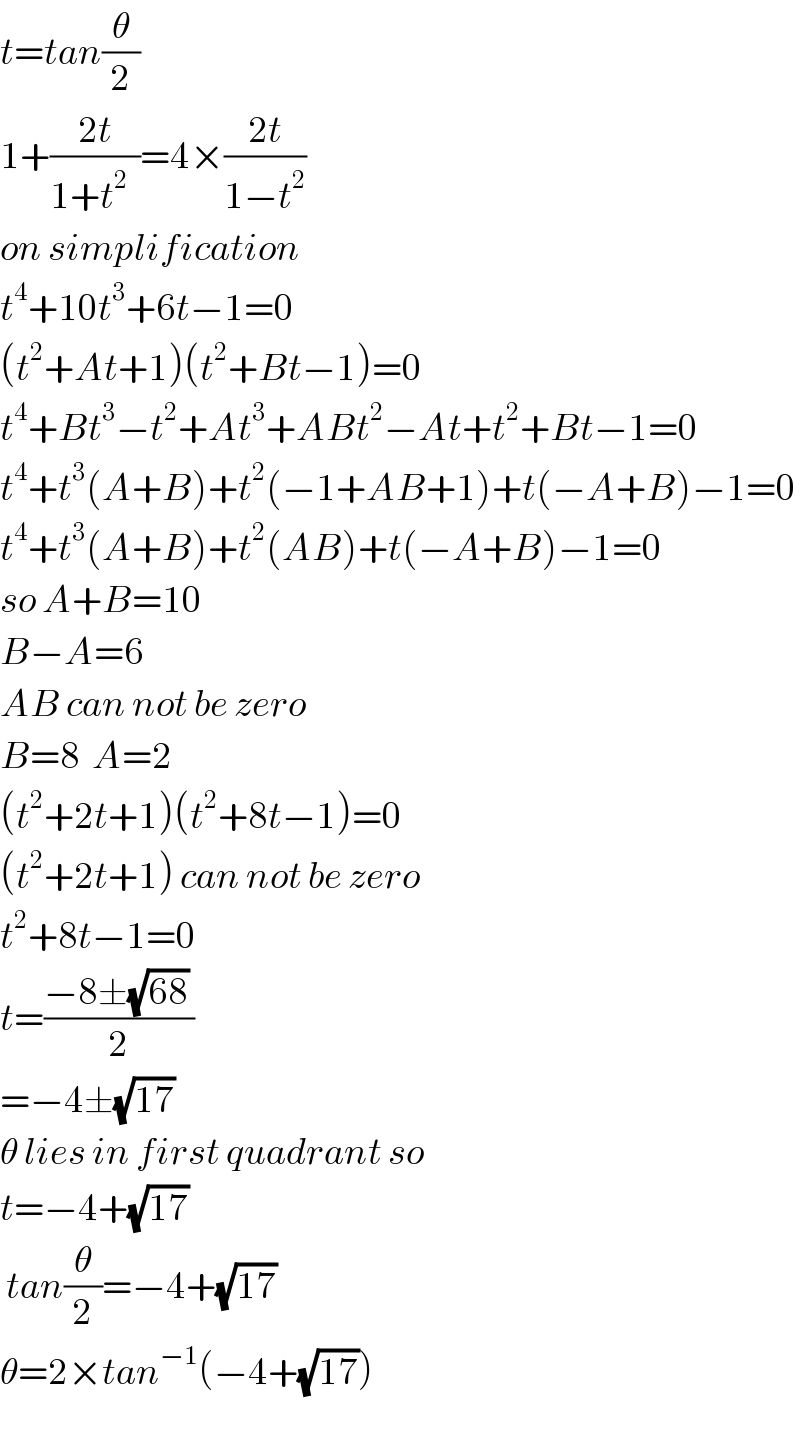
$${t}={tan}\frac{\theta}{\mathrm{2}} \\ $$$$\mathrm{1}+\frac{\mathrm{2}{t}}{\mathrm{1}+{t}^{\mathrm{2}\:\:\:} }=\mathrm{4}×\frac{\mathrm{2}{t}}{\mathrm{1}−{t}^{\mathrm{2}} } \\ $$$${on}\:{simplification}\: \\ $$$${t}^{\mathrm{4}} +\mathrm{10}{t}^{\mathrm{3}} +\mathrm{6}{t}−\mathrm{1}=\mathrm{0} \\ $$$$\left({t}^{\mathrm{2}} +{At}+\mathrm{1}\right)\left({t}^{\mathrm{2}} +{Bt}−\mathrm{1}\right)=\mathrm{0} \\ $$$${t}^{\mathrm{4}} +{Bt}^{\mathrm{3}} −{t}^{\mathrm{2}} +{At}^{\mathrm{3}} +{ABt}^{\mathrm{2}} −{At}+{t}^{\mathrm{2}} +{Bt}−\mathrm{1}=\mathrm{0} \\ $$$${t}^{\mathrm{4}} +{t}^{\mathrm{3}} \left({A}+{B}\right)+{t}^{\mathrm{2}} \left(−\mathrm{1}+{AB}+\mathrm{1}\right)+{t}\left(−{A}+{B}\right)−\mathrm{1}=\mathrm{0} \\ $$$${t}^{\mathrm{4}} +{t}^{\mathrm{3}} \left({A}+{B}\right)+{t}^{\mathrm{2}} \left({AB}\right)+{t}\left(−{A}+{B}\right)−\mathrm{1}=\mathrm{0} \\ $$$${so}\:{A}+{B}=\mathrm{10} \\ $$$${B}−{A}=\mathrm{6} \\ $$$${AB}\:{can}\:{not}\:{be}\:{zero} \\ $$$${B}=\mathrm{8}\:\:{A}=\mathrm{2} \\ $$$$\left({t}^{\mathrm{2}} +\mathrm{2}{t}+\mathrm{1}\right)\left({t}^{\mathrm{2}} +\mathrm{8}{t}−\mathrm{1}\right)=\mathrm{0} \\ $$$$\left({t}^{\mathrm{2}} +\mathrm{2}{t}+\mathrm{1}\right)\:{can}\:{not}\:{be}\:{zero} \\ $$$${t}^{\mathrm{2}} +\mathrm{8}{t}−\mathrm{1}=\mathrm{0} \\ $$$${t}=\frac{−\mathrm{8}\pm\sqrt{\mathrm{68}}\:}{\mathrm{2}} \\ $$$$=−\mathrm{4}\pm\sqrt{\mathrm{17}} \\ $$$$\theta\:{lies}\:{in}\:{first}\:{quadrant}\:{so} \\ $$$${t}=−\mathrm{4}+\sqrt{\mathrm{17}}\: \\ $$$$\:{tan}\frac{\theta}{\mathrm{2}}=−\mathrm{4}+\sqrt{\mathrm{17}}\: \\ $$$$\theta=\mathrm{2}×{tan}^{−\mathrm{1}} \left(−\mathrm{4}+\sqrt{\mathrm{17}}\right)\:\: \\ $$
Commented by Rasheed.Sindhi last updated on 25/May/18

$$\vee\in\mathbb{R}\lambda\:\mathbb{N}{i}\mathbb{C}{e}! \\ $$
Commented by behi83417@gmail.com last updated on 25/May/18

$$\left({t}^{\mathrm{2}} +\mathrm{2}{t}+\mathrm{1}\right)\left({t}^{\mathrm{2}} +\mathrm{8}{t}−\mathrm{1}\right)={t}^{\mathrm{4}} +\mathrm{8}{t}^{\mathrm{3}} −{t}^{\mathrm{2}} +\mathrm{2}{t}^{\mathrm{3}} + \\ $$$$+\mathrm{16}{t}^{\mathrm{2}} −\mathrm{2}{t}+{t}^{\mathrm{2}} +\mathrm{8}{t}−\mathrm{1}={t}^{\mathrm{4}} +\mathrm{10}{t}^{\mathrm{3}} +\mathrm{16}{t}^{\mathrm{2}} +\mathrm{6}{t}−\mathrm{1} \\ $$
Commented by ajfour last updated on 25/May/18

$${Excellent}\:{Sir},\:{i}\:{had}\:{this}\:{in}\:{mind}, \\ $$$${couldn}'{t}\:{find}\:{the}\:{time}\:{n}\:{courage}. \\ $$
Commented by behi83417@gmail.com last updated on 25/May/18

Commented by tanmay.chaudhury50@gmail.com last updated on 25/May/18

$${hanks}… \\ $$
Commented by tanmay.chaudhury50@gmail.com last updated on 25/May/18

$${this}\:{method}\:{of}\:{solve}\:{may}\:{be}\:{the}\:{paradox} \\ $$$${of}\:{mathematics}\:{as}\:{Mr}.{Behi}\:\:{detected}\:{the}\:{flaw} \\ $$
Commented by Rasheed.Sindhi last updated on 26/May/18

$$\mathrm{tanmay}\:\mathrm{Sir} \\ $$$$\mathrm{I}\:\mathrm{don}'\mathrm{t}\:\mathrm{think}\:\mathrm{that}\:\mathrm{your}\:\mathrm{method}\:\mathrm{is}\:\mathrm{paradox}. \\ $$$$\mathrm{Actually}\:\mathrm{your}\:\mathrm{answer}\:\mathrm{suggest}\:\mathrm{AB}=\mathrm{0} \\ $$$$\mathrm{also},\mathrm{which}\:\mathrm{you}\:\mathrm{didn}'\mathrm{t}\:\mathrm{consider}. \\ $$
Commented by Rasheed.Sindhi last updated on 26/May/18
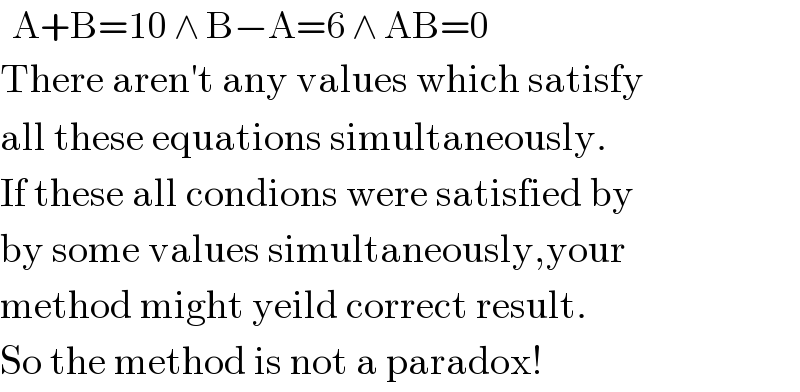
$$\:\:\mathrm{A}+\mathrm{B}=\mathrm{10}\:\wedge\:\mathrm{B}−\mathrm{A}=\mathrm{6}\:\wedge\:\mathrm{AB}=\mathrm{0} \\ $$$$\mathrm{There}\:\mathrm{aren}'\mathrm{t}\:\mathrm{any}\:\mathrm{values}\:\mathrm{which}\:\mathrm{satisfy} \\ $$$$\mathrm{all}\:\mathrm{these}\:\mathrm{equations}\:\mathrm{simultaneously}. \\ $$$$\mathrm{If}\:\mathrm{these}\:\mathrm{all}\:\mathrm{condions}\:\mathrm{were}\:\mathrm{satisfied}\:\mathrm{by} \\ $$$$\mathrm{by}\:\mathrm{some}\:\mathrm{values}\:\mathrm{simultaneously},\mathrm{your} \\ $$$$\mathrm{method}\:\mathrm{might}\:\mathrm{yeild}\:\mathrm{correct}\:\mathrm{result}. \\ $$$$\mathrm{So}\:\mathrm{the}\:\mathrm{method}\:\mathrm{is}\:\mathrm{not}\:\mathrm{a}\:\mathrm{paradox}! \\ $$
Commented by tanmay.chaudhury50@gmail.com last updated on 26/May/18

$${thank}\:{you}..{i}\:{thought}\:{i}\:{made}\:{a}\:{huge}\:{mkstake}.. \\ $$
Commented by behi83417@gmail.com last updated on 26/May/18

$${x}^{\mathrm{4}} +\mathrm{10}{x}^{\mathrm{3}} +\mathrm{6}{x}−\mathrm{1}= \\ $$$$\left({x}^{\mathrm{2}} +\frac{\sqrt{\mathrm{5}}−\mathrm{1}}{\mathrm{2}}\right)\left({x}^{\mathrm{2}} +\mathrm{10}{x}−\frac{\sqrt{\mathrm{5}}+\mathrm{1}}{\mathrm{2}}\right) \\ $$$${what}\:{do}\:{you}\:{think}\:{mr}\:{tanmay}\:\&\:{mr}\:{Rasheed}? \\ $$
Commented by Rasheed.Sindhi last updated on 27/May/18

$$\mathrm{What}\:\mathrm{method}\:\mathrm{did}\:\mathrm{you}\:\mathrm{use}\:\mathrm{to}\:\mathrm{factorize}? \\ $$$$\mathrm{The}\:\mathrm{method}\:\mathrm{Mr}\:\mathrm{tanmay}\:\mathrm{used}\:\mathrm{is}\:\mathrm{failed} \\ $$$$\mathrm{in}\:\mathrm{this}\:\mathrm{particular}\:\mathrm{case}. \\ $$
Commented by $@ty@m last updated on 27/May/18
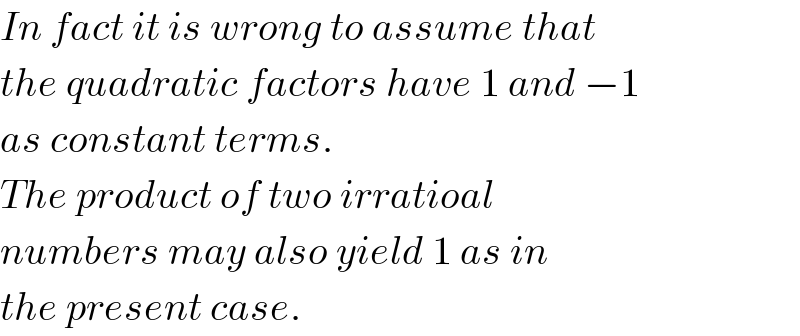
$${In}\:{fact}\:{it}\:{is}\:{wrong}\:{to}\:{assume}\:{that} \\ $$$${the}\:{quadratic}\:{factors}\:{have}\:\mathrm{1}\:{and}\:−\mathrm{1} \\ $$$${as}\:{constant}\:{terms}. \\ $$$${The}\:{product}\:{of}\:{two}\:{irratioal} \\ $$$${numbers}\:{may}\:{also}\:{yield}\:\mathrm{1}\:{as}\:{in} \\ $$$${the}\:{present}\:{case}. \\ $$
Commented by Rasheed.Sindhi last updated on 27/May/18
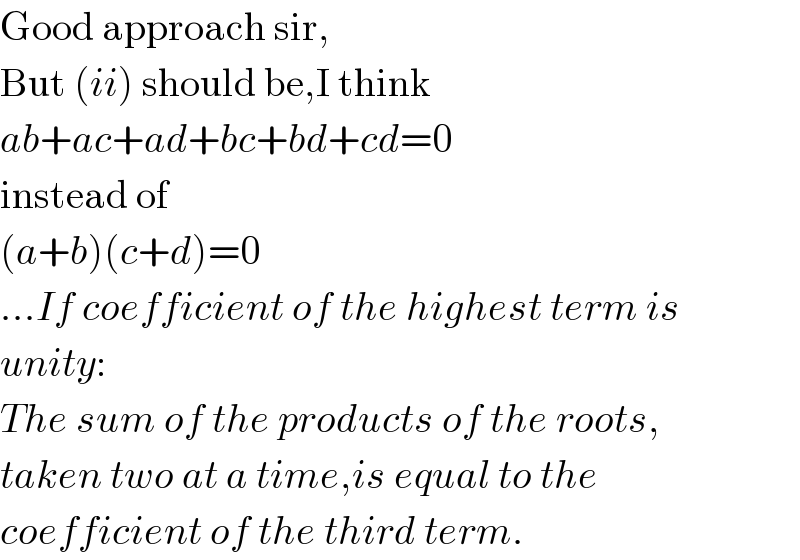
$$\mathrm{Good}\:\mathrm{approach}\:\mathrm{sir}, \\ $$$$\mathrm{But}\:\left({ii}\right)\:\mathrm{should}\:\mathrm{be},\mathrm{I}\:\mathrm{think} \\ $$$${ab}+{ac}+{ad}+{bc}+{bd}+{cd}=\mathrm{0} \\ $$$$\mathrm{instead}\:\mathrm{of} \\ $$$$\left({a}+{b}\right)\left({c}+{d}\right)=\mathrm{0}\: \\ $$$$…{If}\:{coefficient}\:{of}\:{the}\:{highest}\:{term}\:{is} \\ $$$${unity}: \\ $$$${The}\:{sum}\:{of}\:{the}\:{products}\:{of}\:{the}\:{roots}, \\ $$$${taken}\:{two}\:{at}\:{a}\:{time},{is}\:{equal}\:{to}\:{the} \\ $$$${coefficient}\:{of}\:{the}\:{third}\:{term}. \\ $$
Commented by Rasheed.Sindhi last updated on 27/May/18
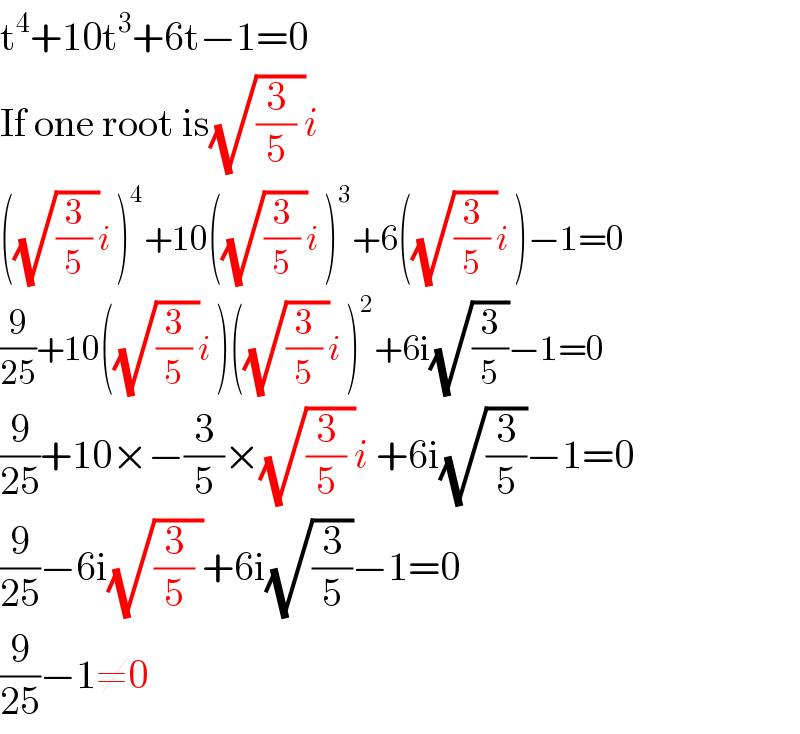
$$\mathrm{t}^{\mathrm{4}} +\mathrm{10t}^{\mathrm{3}} +\mathrm{6t}−\mathrm{1}=\mathrm{0} \\ $$$$\mathrm{If}\:\mathrm{one}\:\mathrm{root}\:\mathrm{is}\sqrt{\frac{\mathrm{3}}{\mathrm{5}}\:}{i}\: \\ $$$$\left(\sqrt{\frac{\mathrm{3}}{\mathrm{5}}\:}{i}\:\right)^{\mathrm{4}} +\mathrm{10}\left(\sqrt{\frac{\mathrm{3}}{\mathrm{5}}\:}{i}\:\right)^{\mathrm{3}} +\mathrm{6}\left(\sqrt{\frac{\mathrm{3}}{\mathrm{5}}\:}{i}\:\right)−\mathrm{1}=\mathrm{0} \\ $$$$\frac{\mathrm{9}}{\mathrm{25}}+\mathrm{10}\left(\sqrt{\frac{\mathrm{3}}{\mathrm{5}}\:}{i}\:\right)\left(\sqrt{\frac{\mathrm{3}}{\mathrm{5}}\:}{i}\:\right)^{\mathrm{2}} +\mathrm{6i}\sqrt{\frac{\mathrm{3}}{\mathrm{5}}}−\mathrm{1}=\mathrm{0} \\ $$$$\frac{\mathrm{9}}{\mathrm{25}}+\mathrm{10}×−\frac{\mathrm{3}}{\mathrm{5}}×\sqrt{\frac{\mathrm{3}}{\mathrm{5}}\:}{i}\:+\mathrm{6i}\sqrt{\frac{\mathrm{3}}{\mathrm{5}}}−\mathrm{1}=\mathrm{0} \\ $$$$\frac{\mathrm{9}}{\mathrm{25}}−\mathrm{6i}\sqrt{\frac{\mathrm{3}}{\mathrm{5}}\:}+\mathrm{6i}\sqrt{\frac{\mathrm{3}}{\mathrm{5}}}−\mathrm{1}=\mathrm{0} \\ $$$$\frac{\mathrm{9}}{\mathrm{25}}−\mathrm{1}\neq\mathrm{0} \\ $$
Commented by $@ty@m last updated on 28/May/18

$${You}\:{are}\:{right}. \\ $$$${I}'{ll}\:{try}\:{again}. \\ $$$${Thanks}\:{for}\:{correcting}\:{me}. \\ $$
Commented by MJS last updated on 29/May/18

$$\left({x}^{\mathrm{2}} +\frac{\sqrt{\mathrm{5}}−\mathrm{1}}{\mathrm{2}}\right)\left({x}^{\mathrm{2}} +\mathrm{10}{x}−\frac{\sqrt{\mathrm{5}}+\mathrm{1}}{\mathrm{2}}\right)= \\ $$$$={x}^{\mathrm{4}} +\mathrm{10}{x}^{\mathrm{3}} −{x}^{\mathrm{2}} +\mathrm{5}\left(\sqrt{\mathrm{5}}−\mathrm{1}\right){x}−\mathrm{1} \\ $$$$\mathrm{so}\:\mathrm{this}\:\mathrm{is}\:\mathrm{wrong} \\ $$
Answered by Rasheed.Sindhi last updated on 28/May/18
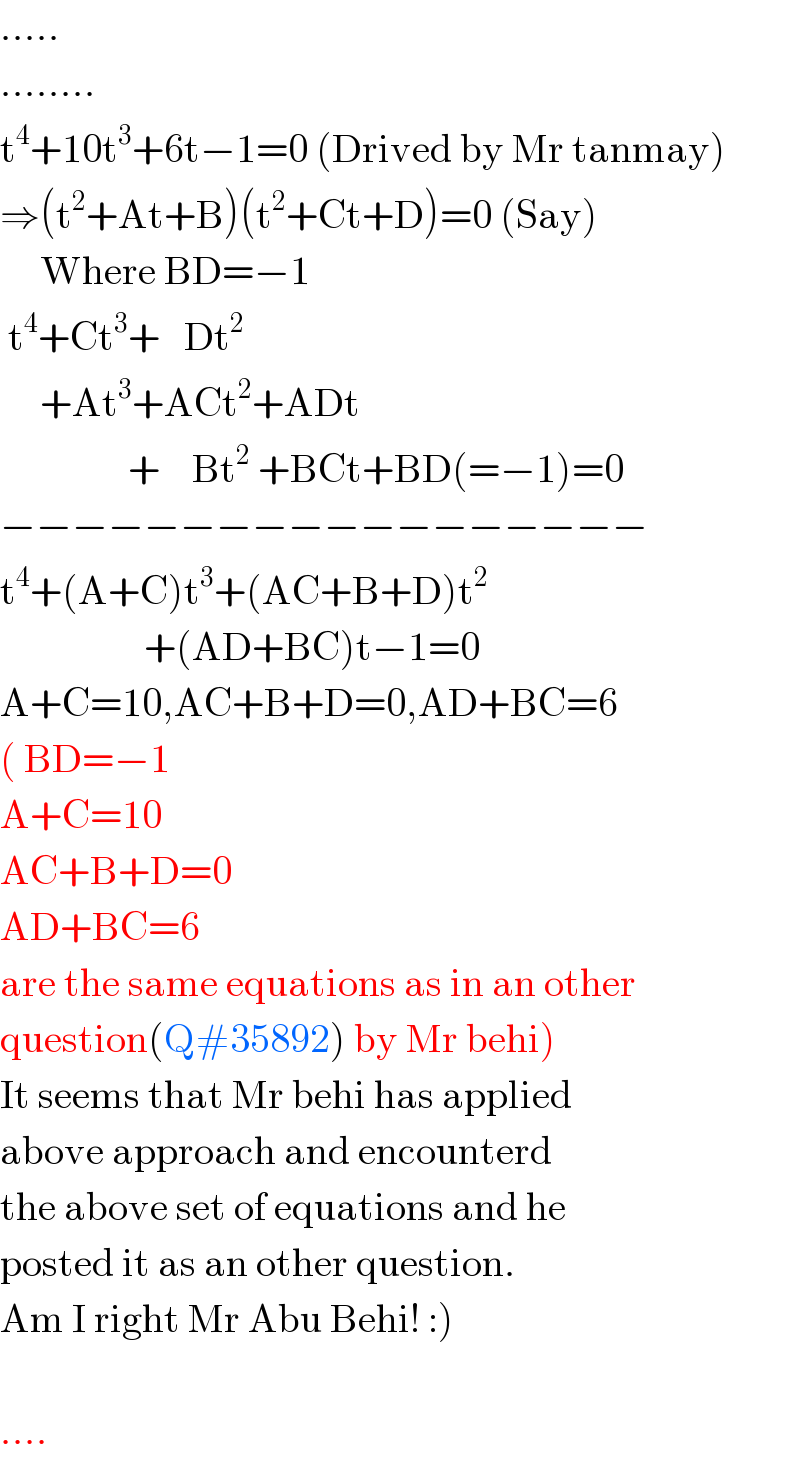
$$….. \\ $$$$…….. \\ $$$$\mathrm{t}^{\mathrm{4}} +\mathrm{10t}^{\mathrm{3}} +\mathrm{6t}−\mathrm{1}=\mathrm{0}\:\left(\mathrm{Drived}\:\mathrm{by}\:\mathrm{Mr}\:\mathrm{tanmay}\right) \\ $$$$\Rightarrow\left(\mathrm{t}^{\mathrm{2}} +\mathrm{At}+\mathrm{B}\right)\left(\mathrm{t}^{\mathrm{2}} +\mathrm{Ct}+\mathrm{D}\right)=\mathrm{0}\:\left(\mathrm{Say}\right) \\ $$$$\:\:\:\:\:\mathrm{Where}\:\mathrm{BD}=−\mathrm{1} \\ $$$$\:\mathrm{t}^{\mathrm{4}} +\mathrm{Ct}^{\mathrm{3}} +\:\:\:\mathrm{Dt}^{\mathrm{2}} \\ $$$$\:\:\:\:\:+\mathrm{At}^{\mathrm{3}} +\mathrm{ACt}^{\mathrm{2}} +\mathrm{ADt} \\ $$$$\:\:\:\:\:\:\:\:\:\:\:\:\:\:\:\:+\:\:\:\:\mathrm{Bt}^{\mathrm{2}} \:+\mathrm{BCt}+\mathrm{BD}\left(=−\mathrm{1}\right)=\mathrm{0} \\ $$$$−−−−−−−−−−−−−−−−−− \\ $$$$\mathrm{t}^{\mathrm{4}} +\left(\mathrm{A}+\mathrm{C}\right)\mathrm{t}^{\mathrm{3}} +\left(\mathrm{AC}+\mathrm{B}+\mathrm{D}\right)\mathrm{t}^{\mathrm{2}} \\ $$$$\:\:\:\:\:\:\:\:\:\:\:\:\:\:\:\:\:\:+\left(\mathrm{AD}+\mathrm{BC}\right)\mathrm{t}−\mathrm{1}=\mathrm{0} \\ $$$$\mathrm{A}+\mathrm{C}=\mathrm{10},\mathrm{AC}+\mathrm{B}+\mathrm{D}=\mathrm{0},\mathrm{AD}+\mathrm{BC}=\mathrm{6} \\ $$$$\left(\:\mathrm{BD}=−\mathrm{1}\right. \\ $$$$\mathrm{A}+\mathrm{C}=\mathrm{10} \\ $$$$\mathrm{AC}+\mathrm{B}+\mathrm{D}=\mathrm{0} \\ $$$$\mathrm{AD}+\mathrm{BC}=\mathrm{6} \\ $$$$\mathrm{are}\:\mathrm{the}\:\mathrm{same}\:\mathrm{equations}\:\mathrm{as}\:\mathrm{in}\:\mathrm{an}\:\mathrm{other} \\ $$$$\left.\mathrm{question}\left(\mathrm{Q}#\mathrm{35892}\right)\:\mathrm{by}\:\mathrm{Mr}\:\mathrm{behi}\right) \\ $$$$\mathrm{It}\:\mathrm{seems}\:\mathrm{that}\:\mathrm{Mr}\:\mathrm{behi}\:\mathrm{has}\:\mathrm{applied} \\ $$$$\mathrm{above}\:\mathrm{approach}\:\mathrm{and}\:\mathrm{encounterd} \\ $$$$\mathrm{the}\:\mathrm{above}\:\mathrm{set}\:\mathrm{of}\:\mathrm{equations}\:\mathrm{and}\:\mathrm{he} \\ $$$$\mathrm{posted}\:\mathrm{it}\:\mathrm{as}\:\mathrm{an}\:\mathrm{other}\:\mathrm{question}. \\ $$$$\left.\mathrm{Am}\:\mathrm{I}\:\mathrm{right}\:\mathrm{Mr}\:\mathrm{Abu}\:\mathrm{Behi}!\::\right) \\ $$$$ \\ $$$$…. \\ $$
Commented by behi83417@gmail.com last updated on 28/May/18

$${mr}\:{Rasheed}!{you}\:{are}\:{right}. \\ $$$${but}\:{i}\:{have}\:{not}\:{solution}\:{for}\:{this}\:{and}\: \\ $$$${I}\:{am}\:{waiting}\:{for}\:{my}\:{friends}\:{such}\:{as} \\ $$$${you}\:{and}\:{mr}\:{tanmay}\:{and}\:{mr}\:{satyam}..! \\ $$
Commented by Rasheed.Sindhi last updated on 28/May/18
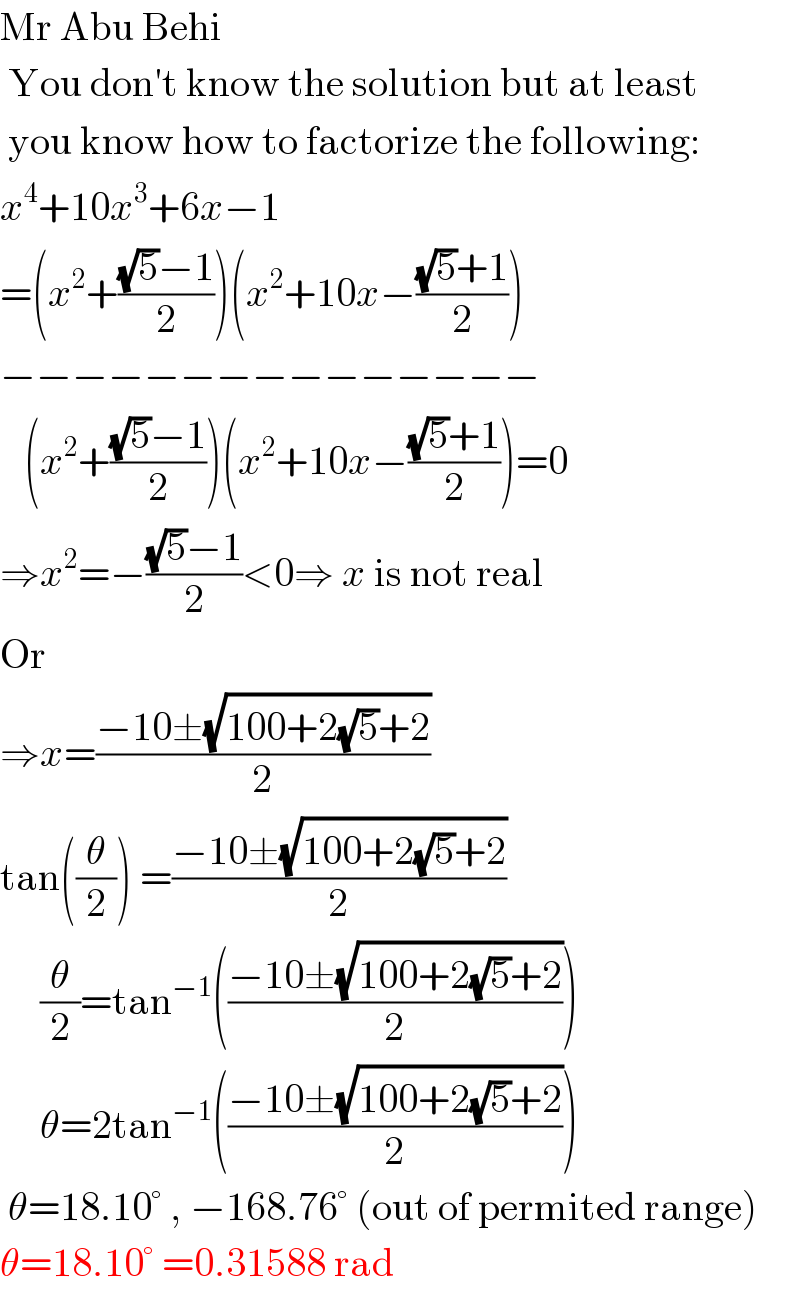
$$\mathrm{Mr}\:\mathrm{Abu}\:\mathrm{Behi} \\ $$$$\:\mathrm{You}\:\mathrm{don}'\mathrm{t}\:\mathrm{know}\:\mathrm{the}\:\mathrm{solution}\:\mathrm{but}\:\mathrm{at}\:\mathrm{least} \\ $$$$\:\mathrm{you}\:\mathrm{know}\:\mathrm{how}\:\mathrm{to}\:\mathrm{factorize}\:\mathrm{the}\:\mathrm{following}: \\ $$$${x}^{\mathrm{4}} +\mathrm{10}{x}^{\mathrm{3}} +\mathrm{6}{x}−\mathrm{1} \\ $$$$=\left({x}^{\mathrm{2}} +\frac{\sqrt{\mathrm{5}}−\mathrm{1}}{\mathrm{2}}\right)\left({x}^{\mathrm{2}} +\mathrm{10}{x}−\frac{\sqrt{\mathrm{5}}+\mathrm{1}}{\mathrm{2}}\right) \\ $$$$−−−−−−−−−−−−−−− \\ $$$$\:\:\:\left({x}^{\mathrm{2}} +\frac{\sqrt{\mathrm{5}}−\mathrm{1}}{\mathrm{2}}\right)\left({x}^{\mathrm{2}} +\mathrm{10}{x}−\frac{\sqrt{\mathrm{5}}+\mathrm{1}}{\mathrm{2}}\right)=\mathrm{0} \\ $$$$\Rightarrow{x}^{\mathrm{2}} =−\frac{\sqrt{\mathrm{5}}−\mathrm{1}}{\mathrm{2}}<\mathrm{0}\Rightarrow\:{x}\:\mathrm{is}\:\mathrm{not}\:\mathrm{real} \\ $$$$\mathrm{Or} \\ $$$$\Rightarrow{x}=\frac{−\mathrm{10}\pm\sqrt{\mathrm{100}+\mathrm{2}\sqrt{\mathrm{5}}+\mathrm{2}}}{\mathrm{2}} \\ $$$$\mathrm{tan}\left(\frac{\theta}{\mathrm{2}}\right)\:=\frac{−\mathrm{10}\pm\sqrt{\mathrm{100}+\mathrm{2}\sqrt{\mathrm{5}}+\mathrm{2}}}{\mathrm{2}} \\ $$$$\:\:\:\:\:\frac{\theta}{\mathrm{2}}=\mathrm{tan}^{−\mathrm{1}} \left(\frac{−\mathrm{10}\pm\sqrt{\mathrm{100}+\mathrm{2}\sqrt{\mathrm{5}}+\mathrm{2}}}{\mathrm{2}}\right) \\ $$$$\:\:\:\:\:\theta=\mathrm{2tan}^{−\mathrm{1}} \left(\frac{−\mathrm{10}\pm\sqrt{\mathrm{100}+\mathrm{2}\sqrt{\mathrm{5}}+\mathrm{2}}}{\mathrm{2}}\right) \\ $$$$\:\theta=\mathrm{18}.\mathrm{10}°\:,\:−\mathrm{168}.\mathrm{76}°\:\left(\mathrm{out}\:\mathrm{of}\:\mathrm{permited}\:\mathrm{range}\right) \\ $$$$\theta=\mathrm{18}.\mathrm{10}°\:=\mathrm{0}.\mathrm{31588}\:\mathrm{rad} \\ $$
Commented by behi83417@gmail.com last updated on 31/May/18
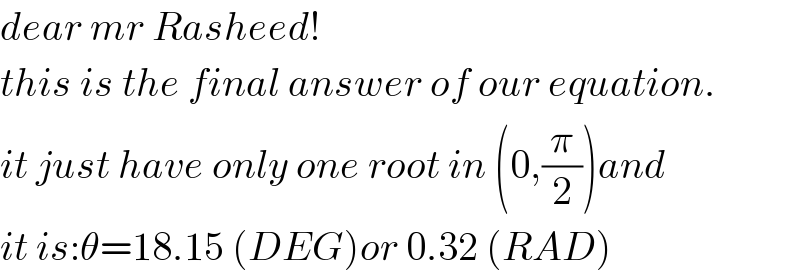
$${dear}\:{mr}\:{Rasheed}! \\ $$$${this}\:{is}\:{the}\:{final}\:{answer}\:{of}\:{our}\:{equation}. \\ $$$${it}\:{just}\:{have}\:{only}\:{one}\:{root}\:{in}\:\left(\mathrm{0},\frac{\pi}{\mathrm{2}}\right){and} \\ $$$${it}\:{is}:\theta=\mathrm{18}.\mathrm{15}\:\left({DEG}\right){or}\:\mathrm{0}.\mathrm{32}\:\left({RAD}\right) \\ $$
Answered by Rasheed.Sindhi last updated on 28/May/18
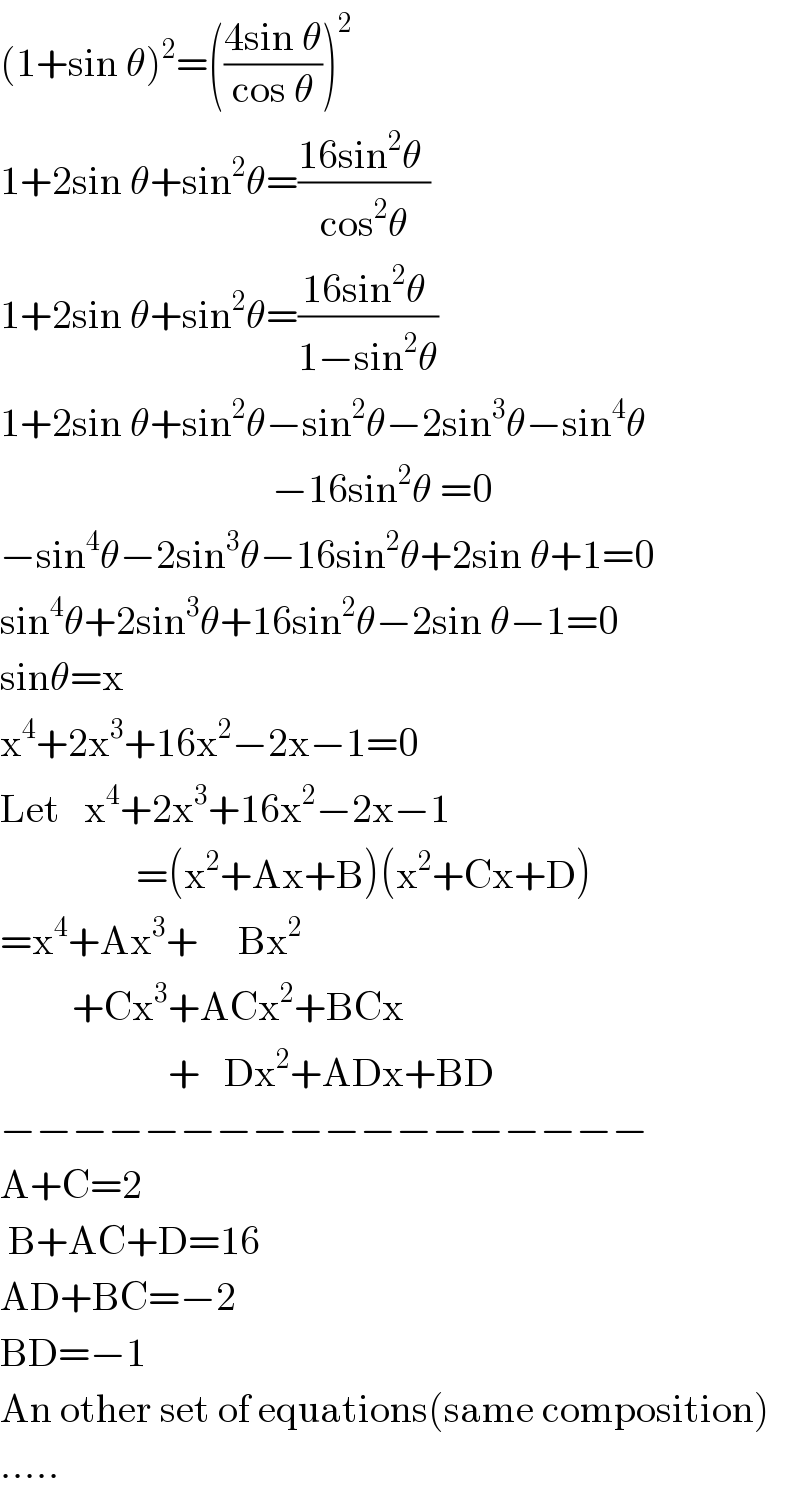
$$\left(\mathrm{1}+\mathrm{sin}\:\theta\right)^{\mathrm{2}} =\left(\frac{\mathrm{4sin}\:\theta}{\mathrm{cos}\:\theta}\right)^{\mathrm{2}} \\ $$$$\mathrm{1}+\mathrm{2sin}\:\theta+\mathrm{sin}^{\mathrm{2}} \theta=\frac{\mathrm{16sin}^{\mathrm{2}} \theta\:}{\mathrm{cos}^{\mathrm{2}} \theta}\: \\ $$$$\mathrm{1}+\mathrm{2sin}\:\theta+\mathrm{sin}^{\mathrm{2}} \theta=\frac{\mathrm{16sin}^{\mathrm{2}} \theta\:}{\mathrm{1}−\mathrm{sin}^{\mathrm{2}} \theta}\: \\ $$$$\mathrm{1}+\mathrm{2sin}\:\theta+\mathrm{sin}^{\mathrm{2}} \theta−\mathrm{sin}^{\mathrm{2}} \theta−\mathrm{2sin}^{\mathrm{3}} \theta−\mathrm{sin}^{\mathrm{4}} \theta\: \\ $$$$\:\:\:\:\:\:\:\:\:\:\:\:\:\:\:\:\:\:\:\:\:\:\:\:\:\:\:\:\:\:\:\:\:\:−\mathrm{16sin}^{\mathrm{2}} \theta\:=\mathrm{0} \\ $$$$−\mathrm{sin}^{\mathrm{4}} \theta−\mathrm{2sin}^{\mathrm{3}} \theta−\mathrm{16sin}^{\mathrm{2}} \theta+\mathrm{2sin}\:\theta+\mathrm{1}=\mathrm{0} \\ $$$$\mathrm{sin}^{\mathrm{4}} \theta+\mathrm{2sin}^{\mathrm{3}} \theta+\mathrm{16sin}^{\mathrm{2}} \theta−\mathrm{2sin}\:\theta−\mathrm{1}=\mathrm{0} \\ $$$$\mathrm{sin}\theta=\mathrm{x} \\ $$$$\mathrm{x}^{\mathrm{4}} +\mathrm{2x}^{\mathrm{3}} +\mathrm{16x}^{\mathrm{2}} −\mathrm{2x}−\mathrm{1}=\mathrm{0} \\ $$$$\mathrm{Let}\:\:\:\mathrm{x}^{\mathrm{4}} +\mathrm{2x}^{\mathrm{3}} +\mathrm{16x}^{\mathrm{2}} −\mathrm{2x}−\mathrm{1} \\ $$$$\:\:\:\:\:\:\:\:\:\:\:\:\:\:\:\:\:=\left(\mathrm{x}^{\mathrm{2}} +\mathrm{Ax}+\mathrm{B}\right)\left(\mathrm{x}^{\mathrm{2}} +\mathrm{Cx}+\mathrm{D}\right) \\ $$$$=\mathrm{x}^{\mathrm{4}} +\mathrm{Ax}^{\mathrm{3}} +\:\:\:\:\:\mathrm{Bx}^{\mathrm{2}} \\ $$$$\:\:\:\:\:\:\:\:\:+\mathrm{Cx}^{\mathrm{3}} +\mathrm{ACx}^{\mathrm{2}} +\mathrm{BCx} \\ $$$$\:\:\:\:\:\:\:\:\:\:\:\:\:\:\:\:\:\:\:\:\:+\:\:\:\mathrm{Dx}^{\mathrm{2}} +\mathrm{ADx}+\mathrm{BD} \\ $$$$−−−−−−−−−−−−−−−−−− \\ $$$$\mathrm{A}+\mathrm{C}=\mathrm{2}\: \\ $$$$\:\mathrm{B}+\mathrm{AC}+\mathrm{D}=\mathrm{16}\: \\ $$$$\mathrm{AD}+\mathrm{BC}=−\mathrm{2} \\ $$$$\mathrm{BD}=−\mathrm{1} \\ $$$$\mathrm{An}\:\mathrm{other}\:\mathrm{set}\:\mathrm{of}\:\mathrm{equations}\left(\mathrm{same}\:\mathrm{composition}\right) \\ $$$$….. \\ $$
Commented by behi83417@gmail.com last updated on 28/May/18

$${mr}\:{Rasheed}!{thank}\:{you}\:{very}\:{much}. \\ $$$${but}\:{how}\:{to}\:{solve}\:{this}\:{set}?\:{new}\:{problem}! \\ $$
